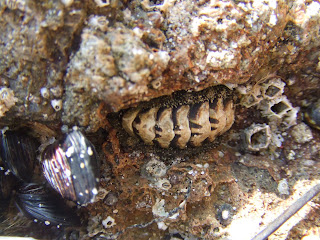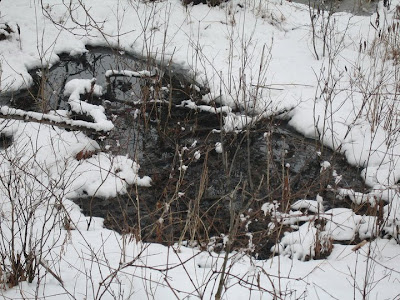Label: Seymour Photographs
May 10, 2010
Big Winds, Fractured Skies
Sunday, Mother’s Day, was very windy with gusts reaching 40 miles per hour. It was sunny and there were many cumulus clouds in the blue skies. But there weren’t the usual puffy cumulus clouds that look like cotton balls.

Instead they were cumulus fractus (or fractocumulus) clouds, sometimes also called "scud" by pilots. Fractus clouds are clouds that are torn by high winds and look very much like cotton balls that have been torn apart by fingers. They change constantly and often move rapidly across the sky.
Posted by: Seymour Simon
April 22, 2010
Turkey Vulture on a tree in my Driveway
Perching on the high branch of a tree at the bottom of the driveway of my house in the Hudson Highlands of New York State, was this "animal that nobody loves," an Eastern Turkey Vulture. The Turkey Vulture is the most common vulture in the New World.
Almost exclusively a scavenger (which means it eats the carcasses of dead animals), the Turkey Vulture rarely kills for its food. The Turkey Vulture tends to hunt by itself. It uses its highly-developed sense of smell to locate carcasses even hidden beneath a forest of trees.
The Turkey Vulture on my tree was hunting in the area of my house which includes farmland with pasture and plenty of undisturbed forested areas for perching, roosting, and nesting. The large bird nests in dark recesses beneath boulders, on cliff ledges, in hollow trees, logs, and stumps, and in abandoned buildings.
Posted by: Seymour Simon
April 1, 2010
We’re walking on the beach and saw…
The top image shows mostly mussels, the middle image are barnacles and the third image is a chiton.

A mussel is a kind of bivalve mollusk similar to a clam (that a lot of people like steamed with a bit of garlic and oil atop a heap of linguine).
Barnacles are a completely different kind of animal, more closely related to crabs and lobster than to clams and mussels. They are not all that tasty and rarely end up in a plate of spaghetti.
Both mussels and barnacles (and chitons as well) attach themselves to rocky surfaces in the tidal zone where they are covered by the sea at high tide and exposed to the air at low tide. They also attach themselves to boats left in the water and to piers and docks. 
Chitons are mollusks with eight overlapping shells (count them), more closely related to mussels and clams than to barnacles.
Posted by: Seymour Simon
March 31, 2010
Seymour shoots the moon; so can you!

I was looking at the moon two nights ago when I decided that I might be able to take a photo of the moon with my new digital camera that has a magnification of about ten times. This is a hand-held photo and I’m just amazed at how clear it is. Why don’t you try to take a photo of the moon yourself with a digital camera? It would be best if you can to increase the ASA speed to 800 or more (ask someone to help if you don’t know how to do this). Also prop the camera on something solid and hold it as steadily as you can. You may have to do a bit of editing to crop the moon to fill the whole frame but it’s easier than you think. In fact, here’s a contest: Best shot of the moon that I get by the end of April gets a brand new signed copy of my book THE MOON.
Posted by: Seymour Simon
March 19, 2010
On the beach after heavy surf
Here’s some kelp I photographed this morning along Carbon Beach in Malibu where I’m staying this month. I was curious about the relative lack of kelp and here’s what I found out about the kelp beds off the shore near Malibu:
That the kelp forests along the coast of Southern California were badly affected by 1) the 1982-1984 El Niño and a devastating storm (the worst in 200 years; 2) the 1992-1994 El Niño and subsequent storms; and 3) the 1997-1998 El Niño, which was the warmest of the three. The warm water and storms associated with the El Niño destroyed plants, inhibited kelp growth, and resulted in minimal canopy development throughout the region. For an 18-year period from 1981 to 1998, sea surface temperatures exceeded the previous 60-year mean in all but a single year, 1988.
Posted by: Seymour Simon
March 1, 2010
Photographing Snow

It has been snowing for days where I live in New York State. The roads were clear by Sunday morning and we took a drive and photographed the incredible sights, with wet, heavy snow coating everything. 
This photograph got me thinking about a fascinating exception that exists in nature. Most non-metallic substances contract as they get colder. Not water, though. Water contracts until it gets down to about 39 degrees F. Then it begins to expand until it freezes and turns into ice. So why is that important? Well, it means that when water turns to ice, the ice forms at the surface rather than at the bottom of a pond, lake or ocean. The warmer water sinks. That’s why ice floats. And that’s one of the reasons that living things in ponds and lakes can survive the winter at the bottom where water is still liquid and not frozen solid.
Posted by: Seymour Simon
February 27, 2010
Snowfall in the country
Wet, soft snow sticks to the branches of trees and coats them until the temperature rises and the snow melts and softly falls to the ground.

Posted by: Seymour Simon
February 23, 2010
CLOSE ENCOUNTER WITH IGUANAS IN ARUBA
Seymour Simon recently visited the island of Aruba, which is in the Caribbean Sea. Seymour takes his camera with him everywhere he goes, because you never know when you might find an interesting creature like this iguana.
The iguana is a protected species on the island of Aruba, and once the warm sun rises in late morning, it is not hard to find an iguana. On the tree trunks, in the bushes, or sunning on the warm tiles by the pool, iguanas seem to be everywhere in Aruba!
This is the iguana that Seymour was photographing.
You can see the row of spines along his back and tail - they help to protect him from predators. You might also notice that this iguana has a pouch of skin underneath his chin. This is called a dewlap, and he can make it seem much bigger than it really is, which is very useful when he is trying to ward off predators. Males use the dewlap to intimidate rivals and also to attract females during the mating season.
Some of the other lizards Seymour saw on Aruba are called Pega Pega - a cousin of the Gecko. They they have suction pads on their feet that allow them to climb straight up the side of the buildings!
Posted by: Liz Nealon
March 31, 2009
Meet the Author - Seymour Simon

Meet the Author - Seymour Simon
Posted by: Seymour Simon
February 13, 2009
Why does a water moccasin cross a trail?
I was walking down a trail in a swampy area near the shore in a National Wildlife Refuge in Virginia when this poisonous snake, a water moccasin, crawled out of the grasses on one side of the trail and headed across to the other side. Naturally, I had no objections. Why does a water moccasin cross a trail?
To get to the other side, of course. ![]()
A water moccasin is also called a cottonmouth or a black moccasin. It’s called a cottonmouth because it will stand its ground and open its jaws, exposing the white lining of its mouth. Adult water moccasins are large and capable of delivering a painful and potentially fatal bite, but their reputation for attacking people without warning is not exactly accurate.
Water moccasins live in the Eastern part of the United States, usually near slow-moving streams and shallow lakes. They are strong swimmers and will even enter the ocean where they will sometimes swim to nearby islands.
Posted by: Seymour Simon




